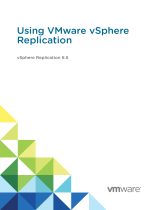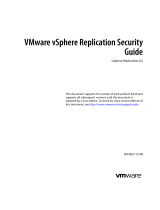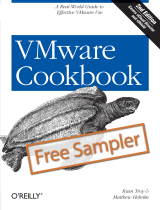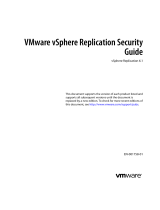
Chapter 1: Getting Started............................................................................................................ 6
Key Features.........................................................................................................................................................................6
Requirements for the vSphere Client Plugin................................................................................................................ 6
Software Requirements............................................................................................................................................... 6
Replication Requirements for VMFS Datastores....................................................................................................7
Configuring Dell Storage vSphere Client Plugin........................................................................................................... 7
VASA Provider......................................................................................................................................................................8
Registering VASA provider.......................................................................................................................................... 8
Unregistering VASA provider...................................................................................................................................... 9
Managing the vSphere Client Plugin...............................................................................................................................9
Changing vCenter and Dell Storage Manager Credentials.................................................................................. 9
Displaying Storage Center Information...................................................................................................................10
Disabling and Enabling the vSphere Client Plugin................................................................................................. 11
Chapter 2: Working With Dell Storage..........................................................................................12
Introduction to Dell Storage............................................................................................................................................ 12
Creating and Managing VMFS Datastores on Storage Centers.............................................................................13
Adding a VMFS Datastore ........................................................................................................................................ 13
Editing Volume Settings............................................................................................................................................. 15
Expanding a Datastore................................................................................................................................................16
Removing a Datastore.................................................................................................................................................16
Configuring, Creating, and Recovering Snapshots.................................................................................................... 17
Applying a Snapshot Profile for a Datastore..........................................................................................................17
Taking a Snapshot of a Datastore............................................................................................................................17
Deleting Snapshots for a Datastore.........................................................................................................................17
Recovering a Datastore From a Storage Center Snapshot............................................................................... 18
Create and Manage Replications and Live Volumes..................................................................................................18
Replication Operations................................................................................................................................................19
Live Volume Operations..............................................................................................................................................21
Chapter 3: Working With Virtual Machines.................................................................................. 25
Deploy Virtual Machines to an Existing VMFS Datastore....................................................................................... 25
Deploy Virtual Machines to a New VMFS Datastore................................................................................................26
Chapter 4: Viewing Dell Storage Information............................................................................... 28
Viewing the Host Settings.............................................................................................................................................. 28
Connectivity Legend...................................................................................................................................................28
Adapter Details.............................................................................................................................................................29
Storage Details.............................................................................................................................................................29
Configuring Storage Center Connections................................................................................................................... 29
Using Dell Storage Views................................................................................................................................................ 30
Viewing General Information.................................................................................................................................... 30
Viewing Usage Statistics........................................................................................................................................... 32
Viewing Connectivity Information........................................................................................................................... 33
Contents
4 Contents























